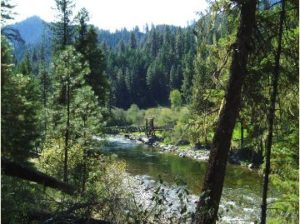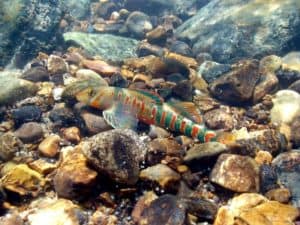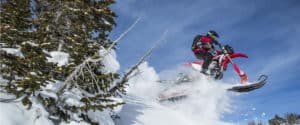On a recent thread about getting land management decision “right,” I criticized an agency strategy of not identifying a preferred alternative in a draft EIS , using an example from BLM travel planning. I said I was seeing more or this in land management planning, and here is an example from the Nez Perce-Clearwater forest plan revision.
A preferred alternative is not identified in the DEIS. Any individual component of any alternative analyzed in the DEIS may be combined into a preferred alternative. A preferred alternative will be identified with the release of the Final Environmental Impact Statement and Draft Record of Decision in 2021.
The link is to the DEIS Executive Summary, and here is their range of alternatives:
Four action alternatives were developed based on internal and external input, including collaboration on alternative development. All alternatives analyzed in the draft environmental impact statement met a minimum bar of being ecologically, socially, and economically sustainable per the 2012 planning rule. Furthermore, each alternative contributes to rural prosperity and other Department of Agriculture Strategic Goals. Alternative themes and the thought process behind their development are described below:
Alternative W
Resources and land allocation on the Nez Perce-Clearwater are not mutually exclusive. It may be possible to have high levels of timber harvest; sustain rural economies; recover fish and wildlife species listed within the Endangered Species Act; provide clean air and clean water; and provide habitat for viable populations of wildlife species all at the same time. For instance, areas evaluated for recommended wilderness are independent from most areas that provide for timber harvest due to the Idaho Roadless Rule. As such, it is possible to recommend all or nearly all Idaho Roadless Rule areas for recommended wilderness and have a very high level of timber outputs. Alternative W is a “have it most” alternative. The intent is to couple items that may otherwise be viewed as being mutually exclusive. This alternative has higher levels of recommended wilderness coupled with a higher timber output and a faster rate of movement towards forest vegetation desired conditions. Forest vegetation desired conditions would be minimally met within thirty years. Areas not selected as recommended wilderness allow for motorized use, including within Idaho Roadless Rule areas. Wild and Scenic Rivers found suitable stem from a collaborative approach that looks at rivers outside the wilderness.
Alternative X
Alternative X responds to a number of state and local plans, which call for few or no areas of recommended wilderness fewer or no suitable wild and scenic rivers and higher timber outputs. In this alternative zero areas are recommended as wilderness. The Comprehensive Water Plan is used as a surrogate to continue to protect key tributaries to the North and South Fork Clearwater Rivers while not pursuing Wild and Scenic River Suitable status on any river. Forest vegetation would be within the lower bound of the desired conditions within twenty years. Alternative X has the highest timber output, including a departure from the Sustained Yield Limit (SYL) for a period of two decades at 241-261 million board feet annually.
Alternative Y
Alternative Y provides for intermediate level of recommended wilderness and moves towards forest vegetative desired conditions in fifty years. Historic snowmobiling areas in the Great Burn are removed from consideration as recommended wilderness resulting in a boundary change, but within the areas moving forward as recommended wilderness we do not authorize any uses that may preclude designation as wilderness in the future. This alternative also looks at the major rivers not designated in the Wild and Scenic Rivers Act as suitable for inclusion in the Wild and Scenic River system. The major rivers not designated include the North Fork Clearwater and South Fork Clearwater.
Alternative Z
Alternative Z responds to requests to have an alternative in which natural processes dominate over anthropogenic influence. In this alternative a proposal for recommended wilderness that was brought forward by a group of national and state wilderness advocacy groups was mostly carried forward. Additionally, rivers were viewed as part of a larger system and major tributaries to the Nez PerceClearwater’s largest rivers will be analyzed as being suitable for inclusion in the wild and scenic rivers system. Areas in Idaho Roadless Rule Areas will not be opened up for additional motorized use and most current motorized use would not be impacted. Reliance on natural process would warrant a slower movement towards forest vegetation desired conditions within an anticipated one-hundred-years or longer. Timber outputs would also be lower and near a lower threshold needed to provide for economic sustainability and sustain rural economies. Additional plan components related to snag guidelines, live tree retention, fisher habitat, and elk security are included that limit uncertainty regarding how and where these features will be located on the landscape.
According to the forest supervisor in this article, “Emphasized in this planning process is the alternatives were put together as building blocks, Probert said, so pieces could potentially be mixed and matched to provide better combinations.”
My question is does it facilitate public comments, or more generally facilitate the process, to not identify a preferred alternative? This range of alternatives seems reasonable. It is based primarily on varying how “designated areas” would be identified and recommended (wilderness and wild and scenic rivers) and managed (inventoried roadless areas, including addressing motorized and mechanized recreation), and how actively or passively the vegetation would be managed. I’ve suggested something along these lines, and maybe if all the alternatives are truly reasonable and focused on the most relevant issues, it would be possible for an agency to not have a preferred alternative. But is it a problem that the final preferred alternative doesn’t look much like any of the alternatives offered for public comments? Still, I’m skeptical that the Nez Perce-Clearwater doesn’t care, and if they do, the law requires that they tell the public.





